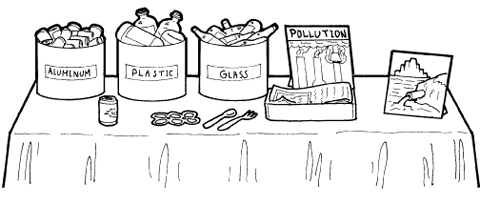 A little background…
A little background…
Earth Day was first held in the United States on April 22, 1970, and was founded by United States Senator Gaylord Nelson. The second Earth Day, held on April 22, 1990, was celebrated in over 140 countries. Earth Day is a day to remind us of the need to care for our environment.
Another related holiday held nationally in the United States on the last Friday of April is Arbor Day, a day to plant new trees and emphasize conservation. It was first held in Nebraska on April 10, 1872, and its founder was conservation advocate Julius Sterling Morton. The date for Arbor Day may vary depending on the state in which you live.
Earth Day Activities
Start a school-wide recycling program. Collect aluminum cans, plastic bottles, paper, and glass. Put collection points around the school. If possible, have a curbside drop-off point one day a week so the public can support your efforts. Recruit some adults to help with transportation to a recycling center. This may be coordinated by your class or by your school’s student government. Decide on a worthwhile organization that helps the earth and contribute the money you earn to it.
Create a bulletin board entitled “Our Dreams for Our Environment.” Divide the board into halves labeled “good dreams” and “bad dreams.” On the good side, put paintings or drawings which represent a clean, safe environment. On the bad side, put illustrations to represent what will happen to the environment if we don’t take better care of the earth.
Another idea for a bulletin board… Use the classified section of the newspaper as the background for this bulletin board. Title the board “The Daily Planet.” Throughout the unit, have students bring in and post articles from newspapers or magazines that tell about environmental problems that the world is facing.
More bulletin board ideas… If you don’t have time to create a bulletin board yourself, check out the Green Earth Bulletin Board from Susan Winget.
Discuss how the air can be cleaned up.
Have students design a mode of transportation that would not pollute the air.
Make a class weather station, including a wind sock, wind vane, anemometer, and rain gauge. Students can make instruments individually or in teams. Then hold an Air, Wind, and Weather Open House to share the products of the unit. Invite the school principal, parents, another class, and/or others.
Have your students design posters for Earth Day. They can be displayed in the classroom, in the library, throughout the school, and in the community.
Hold an Earth Day bookmark contest. Have your class make up the contest rules and forms. Select a winner from each grade level. Duplicate the bookmarks of the winners and distribute them to the students at your school. See if your public library will duplicate and distribute them, too.
Set up an art center where students create art work from recyclable material including anything that they can use in a way different from the way it was originally used. This might include old buttons, fabric scraps, or lace trim as well as more typical “trash.”
Make seed pictures. Draw simple shapes onto small pieces of colored tagboard. Glue a variety of seeds onto the shapes.
Create fruit and vegetable mobiles. Have students identify a grouping (e.g., vegetables that are seeds or fruits with pits) and draw, color, and cut out representative examples. Attach these to the bottoms of coat hangers with string or yarn. Mount the title from the top of the hanger.
Learn about careers related to plants. Be sure to include nursery workers, landscape architects, gardeners, farmers, horticulturists, arborists, and botanists. Have students interview nursery workers or research the occupations and present their findings to the class. Invite some of these workers to school as guest speakers or take field trips to visit places of work.
Assess students’ knowledge of environmental issues by completing a word web using the word “pollution” or “environment.” Discuss the different types of pollution that exist in the world, especially any problems that are prevalent in your own community.
Students can write letters to city officials, senators, representatives, and even the president, urging them to pass laws which protect the environment. Have them include some of their concerns and ideas for possible solutions.
Hand out awards to students who demonstrate good knowledge and practice of environmental sustainability. Click here to print out a sample SAVE OUR EARTH AWARD.
Be sure to subscribe to The TCR Update to get more free e-books and other special offers every month.

 A little background…
A little background…